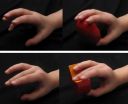Touch-sensing neurons are multitaskers
2015-04-09
(Press-News.org) Two types of touch information -- the feel of an object and the position of an animal's limb -- have long been thought to flow into the brain via different channels and be integrated in sophisticated processing regions. Now, with help from a specially devised mechanical exoskeleton that positioned monkeys' hands in different postures, Johns Hopkins researchers have challenged that view. In a paper published in the April 22 issue of Neuron, they present evidence that the two types of information are integrated as soon as they reach the brain by sense-processing brain cells once thought to be incapable of such higher-order thought.
Past studies have indicated that the feel of an object against the skin and position information of the hands and fingers were processed separately in the sensory system's first-line sense processors, and then passed along to more sophisticated brain regions to be integrated. But it was a challenge to reliably differentiate brain activity caused by the two inputs from one another and from the brain's commands to muscles, says Manuel Gomez-Ramirez, Ph.D. , an assistant research scientist at The Johns Hopkins University. To solve that problem, Steven Hsiao, Gomez-Ramirez's late mentor, and his colleagues developed a machine that positions a monkey's hand and delivers stimuli to its fingers.
In this experiment, then-graduate student Sung Soo Kim, Ph.D., now a research specialist at the Howard Hughes Medical Institute, trained monkeys to perform an unrelated visual task while their hands were manipulated by the machine, which moved their fingers slightly from side to side and up and down at precise angles. The machine also pressed a plastic bar to the monkeys' fingertips in different orientations. By monitoring the monkeys' brains in real time, the research group saw that the position and touch information were conveyed through the same cells in the somatosensory cortex.
"This study changes our understanding of how position and touch signals are combined in the brain," says Gomez-Ramirez. This information could be used in efforts to better integrate prostheses with patients' brains so that they behave more like natural limbs, he notes.
"Holding objects and exploring the world with our hands requires integrating many sensory signals in the brain and continuously supplying this information to motor areas so that it can issue the appropriate commands for holding objects," Gomez-Ramirez says. "Our understanding of how these processes occur is very limited, and Steve Hsiao spent a lot of time thinking about the problem and figuring out how to test it."
INFORMATION:
Pramodsingh H. Thakur of The Johns Hopkins University was also an author on the paper.
[Attachments] See images for this press release:

ELSE PRESS RELEASES FROM THIS DATE:
2015-04-09
It turns out sea turtles, even at a tender 6-18 months of age, are very active swimmers. They don't just passively drift in ocean currents as researchers once thought. NOAA and University of Central Florida researchers say it's an important new clue in the sea turtle "lost years" mystery. Where exactly turtles travel in their first years of life, before returning to coastal areas as adults to forage and reproduce, has puzzled scientists for decades.
"All species of sea turtles are endangered or threatened under the Endangered Species Act; knowing their distribution is ...
2015-04-09
Building on their discovery of a gene linked to eating disorders in humans, a team of researchers at the University of Iowa has now shown that loss of the gene in mice leads to several behavioral abnormalities that resemble behaviors seen in people with anorexia nervosa.
The team, led by Michael Lutter, MD, PhD, assistant professor of psychiatry in the UI Carver College of Medicine, found that mice that lack the estrogen-related receptor alpha (ESRRA) gene are less motivated to seek out high-fat food when they are hungry and have abnormal social interactions. The effect ...
2015-04-09
WASHINGTON -- Facial plastic surgery may do more than make you look youthful. It could change -- for the better -- how people perceive you. The first study of its kind to examine perception after plastic surgery finds that women who have certain procedures are perceived as having greater social skills and are more likeable, attractive and feminine.
The study is not superficial -- the importance of facial appearance is rooted in evolution and studies suggest that judging a person based on his or her appearance boils down to survival. The results were published online ...
2015-04-09
Facial rejuvenation surgery may not only make you look younger, it may improve perceptions of you with regard to likeability, social skills, attractiveness and femininity, according to a report published online by JAMA Facial Plastic Surgery.
The relationship between facial features and personality traits has been studied in other science fields, but it is lacking in the surgical literature, according to the study background.
Michael J. Reilly, M.D., of the MedStar Georgetown University Hospital, Washington, and coauthors measured the changes in personality perception ...
2015-04-09
Axillary lymph node evaluation is performed frequently in women with ductal carcinoma in situ breast cancer, despite recommendations generally against such an assessment procedure in women with localized cancer undergoing breast-conserving surgery, according to a study published online by JAMA Oncology.
While axillary lymph node evaluation is the standard of care in the surgical management of invasive breast cancer, a benefit has not been demonstrated in ductal carcinoma in situ (DCIS). For women with invasive breast cancer, sentinel lymph node biopsy (SLNB) replaced ...
2015-04-09
LAWRENCE -- A team of scientists at the University of Kansas has pinpointed six chemical compounds that thwart HuR, an "oncoprotein" that binds to RNA and promotes tumor growth.
The findings, which could lead to a new class of cancer drugs, appear in the current issue of ACS Chemical Biology.
"These are the first reported small-molecule HuR inhibitors that competitively disrupt HuR-RNA binding and release the RNA, thus blocking HuR function as a tumor-promoting protein," said Liang Xu, associate professor of molecular biosciences and corresponding author of the paper.
The ...
2015-04-09
As we age, the physical make up of our brains changes. This includes changes in neural processing in grey matter, but also in the deterioration of structural connections in the brain, which allow communication between distinct brain regions, so the brain is able to work as a well-wired network system.
Researchers at the Lifelong Brain and Cognition Lab at the Beckman Institute for Advanced Science and Technology at the University of Illinois have utilized the magnetic resonance imaging (MRI) facilities available in Beckman's Biomedical Imaging Center to measure the moment-to-moment ...
2015-04-09
Every year, 300,000 pregnant women and 2,600,000 newborn babies are estimated to die worldwide, and more than 99% of these deaths occur in developing countries. Effective interventions to reduce maternal and neonatal mortality are critically needed, and an ongoing challenge for researchers and health professionals is finding the best way to deliver these interventions in resource-limited settings such as Mongolia. Antenatal visits can provide the first opportunity to deliver these interventions. Now, a new study has shown that Japan's flagship intervention, the Maternal ...
2015-04-09
The question if humans can communicate via pheromones in the same way as animals is under debate. Cell physiologists at the Ruhr-Universität Bochum have demonstrated that the odorous substance Hedione activates the putative pheromone receptor VN1R1, which occurs in the human olfactory epithelium. Together with colleagues from Dresden, the Bochum-based researchers showed that the scent of Hedione generates sex-specific activation patters in the brain, which do not occur with traditional fragrances. "These results constitute compelling evidence that a pheromone effect ...
2015-04-09
Well intentioned, but costly and potentially problematic. That's how researchers describe the end result of a decision by the Food and Drug Administration (FDA) to regulate colchicine, a drug used to treat gout, among other ailments. Fewer patients are actually now taking it, and it has come at a cost to their wallets, says study leader Aaron Kesselheim of Brigham and Women's Hospital and the Harvard Medical School in the US. The findings¹ appear in the Journal of General Internal Medicine,² published by Springer.
Colchicine had been sold at low cost for many ...
LAST 30 PRESS RELEASES:
[Press-News.org] Touch-sensing neurons are multitaskers



